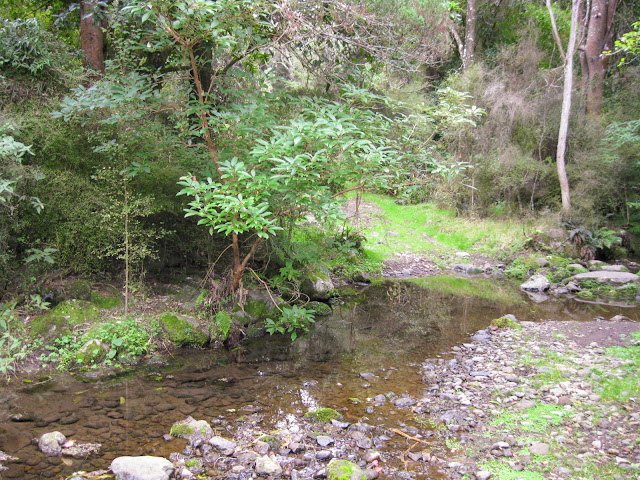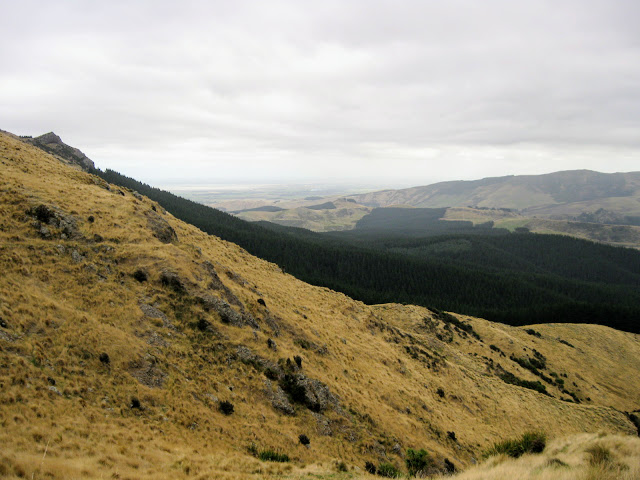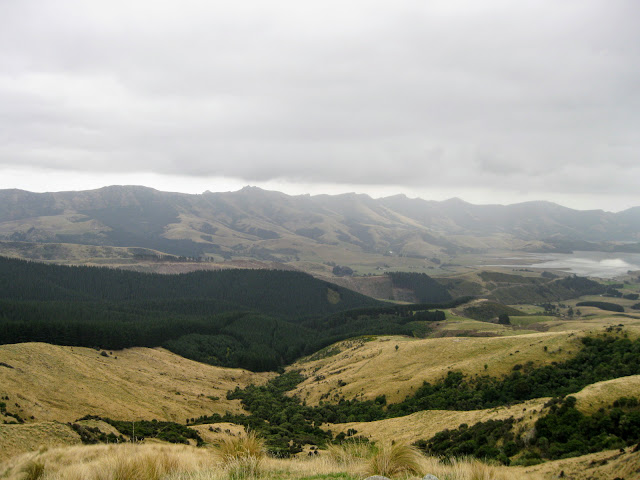A trip to an old favourite: Packhorse Hut
A planned trip to Arthur's Pass was postponed because of rain in the mountains. As an alternative I decided to do a day trip up to the historic Packhorse Hut on Banks Peninsula.
 |
| Packhorse Hut, Banks Peninsula |
The track to the hut starts mid way up the Kaituna Valley, 4 kms in length with a 700 metre altitude gain. The advised time for the track is 4 hours return, I finished in about 3 hours total, and I am sure that fitter people could do it in a much shorter time frame.
 |
| Kaituna Valley to Packhorse Hut, Banks Peninsula |
On the Kaituna-Packhorse Hut track
You start the Kaituna to Packhorse Hut Track mid way towards the head of Kaituna Valley. Follow Kaituna Valley Road to Parkinson's Road and travel down it to the obvious parking spot near the farm buildings. There are signs on both Kaituna Valley Road and Parkinson Road to direct you.
 |
| Kaituna to Packhorse Hut walk- not 4 hours, 2 up, 1 down |
The track crosses farmland for the first 1 km, and then starts to climb up a steep bulldozer track over the middle reaches. The final part of the track is over grassy (and steep) fields.
 |
| Kaituna Valley car park, start of the Kaituna-Packhorse Hut track |
Here is the sizeable car-park close to the Kaituna farm buildings, I think cars would be quite secure here overnight.
 |
| Crossing farm land on the Kaituna-Packhorse Hut track |
Most of the track is on a farm track winding over the fields and up a spur rising to the hut location.
 |
| 'A mighty torrent', unnamed stream on the Kaituna-Packhorse hut track |
This is one of the small creeks you cross on the way up hill, there are three crossings in total. The flow is very low at this time of the year, but I have seen a picture of trampers fording this stream and the water is halfway up their thighs.
 |
| Native Ongaonga thistle...do not touch as it is poisonous! |
While walking up the track try not to touch this plant, this is Ongaonga a native thistle with extremely potent neurological toxins in it. It is prolific along the tracks and in the bush on Banks Peninsula.
DO NOT TOUCH!!!
 |
| Kaituna-Packhorse Hut Track, view of Kaituna Valley |
The track about half way up the hill looking back towards Kaituna valley, you cannot see how steep this path is but the angle would be at least 45 degrees at this point, so STEEP!
 |
| Bush remnant climbing flank of Mt Bradley, Banks Peninsula |
Many of the side gullies have remnants of the native bush, this one was mostly under story but with some truly magnificent trees at least 40 meter high as well. I could hear what sounded like hundreds of native birds singing, these hill side pockets are a refuge for Tui, Bellbirds and Keruru (native wood pigeons).
 |
| Massive native tree in bush remnant near Kaituna Saddle |
The tree above was probably a hundred plus feet tall, with two fat pigeons sitting on the top branches.
 |
| First glimpse of Packhorse Hut, Banks Peninsula |
Here we see our first glimpse of the hut as you reach the saddle...the track continues on to Mt Herbert and at 926 a.s.l. it is the highest peak on Banks Peninsular.
 |
| View of the upper reaches of Lyttelton Harbour from Kaituna Saddle |
From the top you have expansive views to Lyttelton Harbour, Gebbies Pass, both coasts and the Southern Alps (when they are not clouded in).
 |
| View towards Gebbies Pass from Kaituna Pass |
 |
| Lyttleton harbour from near Packhorse Hut |
 |
| The Port Hills and Sugar Loaf in distance from Kaituna Saddle |
It took me just over two hours to cover the 6 odd kilometers from the Kaituna carpark to the hut itself.
Historic Packhorse Hut:
Packhorse Hut was built in 1916 as one of a string of huts along the crater of Lyttleton Harbour. Eventually they were meant to be linked by a track but this was never fully completed. The huts were part of the early Canterbury environmentalist Harry Ell's vision of a walking track from Godley Heads to Akaroa across the top of the ridges.
 |
| The Packhorse Hut, attractive stone exterior on Kaituna Saddle |
 |
| Entrance to Packhorse Hut, Kaituna Saddle, Banks Peninsula |
Other huts built as part of this plan were the Sign of the Takahe, Sign of the Kiwi, Sign of the Bellbird and a now gone hut built close to Hilltop. It lives again in the Te Ara Pataka Walkway from Gebbies Pass to Hilltop over 1-2 days.
 |
| Packhorse Hut from the front... |
It is one of only a dozen rock built huts managed by DOC...two others are the Mt Aspiring Hut, one in the Kaweka Range and one on the Tongariro Crossing so it is in good company.
 |
| Cosy interior of the Packhorse Hut, Banks Peninsula |
 |
| Packhorse Hut, the dining area..... |
Jon ate his lunch and got a brew going as you do on a short day hike with a hut at the end. I would love to do an overnight trip here but it is very popular because it is so close to Christchurch. On the previous Saturday there were 12 people in this 9 person hut.
 |
| One of the bunk rooms in the Packhorse Hut |
Look at that view, it would be magical sitting here with a meal in front
of you, a brew and a roaring fire warming the interior, how could you
resist.
 |
| Excellent view from inside of Packhorse Hut down to Lyttleton |
 |
| Packhorse Hut from the rise next to the hut... |
 |
| View down to Kaituna Valley from high on the Kaituna-Packhorse Hut track |
After an hour I headed back down to the car park following the same route. There are three other ways to visit the hut...the first is from Gebbies Pass along the track through McQueens Forest. The other two are from the Orton Bradley estate via the Tablelands or the track around the back of Mt Bradley both take about 3-5 hours.
 |
| Kaituna-Packhorse Hut track, on the way back down to the car park |
 |
| Very steep slope on way down Kaituna-Packhorse Hut track |
Above is a very steep part of the bulldozer track with at least a 30 degree slope, thankfully it is only this steep for about 300 meters or it would be a total gut buster. A very pleasant spot to visit in its own right, and a great spot if it is raining in the Southern Alps.
Access: Via a track over farm land from Kaituna Valley, some seasonal restrictions.
Track Times: 6 kilometers or 3-4 hours return from the carpark, 2 hours up- 1.5 hours down
Hut Details: Packhorse Hut; serviced (booking required from 2017) 9 bunks, wood burner, water tank, wood shed
Miscellaneous: 2017: Packhorse is now on the DOC hut booking system and MUST BE booked before an overnight stay. It has been reconfigured as a 9 bunk hut. It is part of Te Ara Pataka (The Summit Walkway) track from Hilltop Tavern overlooking Akaroa to Gebbies Pass.














